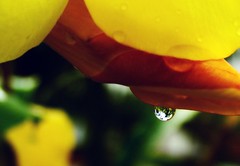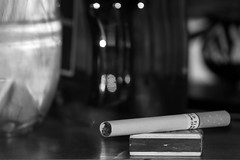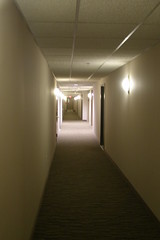Photographing people is a very interesting pastime. I always believe that a photograph should tell you a story. In a portrait, the face is your canvas, and the expression you capture is your story.
Composing a portrait is very challenging as a photo artist, but I try to follow some standard techniques, which I have learnt from different online photo forums and websites, and interpreted as per my understanding, and personal creativity. Always remember, since these are my understanding, it may not always agree with the conventional, but also remember that photography is a creative expression, and use your creativity to shoot great photos which you really like.
In this article I would stick to what you call a conventional portrait. Portraits can also be unorthodox, but I would not cover it in this part of the article here. You can visit some of the portrait groups in
Flickr to see some stunning portraits taken by some of the members.
Ok ... so here goes the tips
Put one eye of the subject on a diagonalThis is a very standard portrait technique, derived from the standard photographic techniques. Human mind is very fond of the diagonal pattern, and follows the diagonal in the photo, either visible or imaginary.
Of the two diagonals, the one from bottom left to top right is more interesting!!!
 Choice of background and understanding colors
Choice of background and understanding colorsWhen you compose a photo, your frame should be minimalistic and uncluttered. Human mind tends to lose focus when it has too much of subject to digest. Use a background of a muted color. If you are shooting outdoors, use a shallow Depth of Field, to blur out the background.
The following photo uses a "bokeh" (blurred) background.
I had an interesting insight while shooting at my cousin's wedding. Indian weddings are traditionally a "RED" affair. People wear red and decorate the marriage hall with red. Now red is a color in photography, which immediately draws attention. The bride was wearing a red saree, sitting on a red throne on a red dias. Now that's a photographic nightmare.. since everything else but the bride was clamouring for attention. To top it all, everything was creating a red color cast. In this situation, I would go for a black and white shoot. For example this shot of Garima, wearing a red dress, but done in black and white.
 Creative use of Shadows and lights
Creative use of Shadows and lightsThis tip is my own. I like to use shadows to create an aura of mystery. Although I received a fair amount of negative criticism on this technique, I still like it!!! Judge for yourself.

This photo violates the rule of diagonals, and some monitors, will be a little too dark. I like it all the same.
Use of spaceIf your subject is looking at a particular direction, try to include some space there. This creates interest of the viewers on the invisible object your subject is viewing.
For example see the following portrait
Use of creative lightingExperiment with directional lighting. You will get surprised with your results. For example, in the picture below I was planning to use light bounced from the ceiling. However the model (My wife) was standing too close to the powerful flash and got some harsh light on the top-right. I know that's a mistake, but I decided to keep the shot, as I found it to contain a lot of mystery.
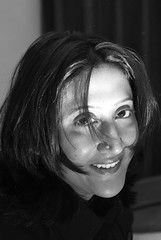 Use of textures
Use of texturesWell, this is a common tip. Many photographers shoot old people to capture the wrinkles. See this technique in action from a different perspective: Water drops and a wet texture on my son's face.
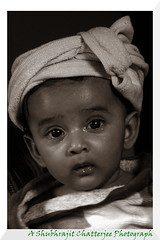
Last, I would ask you to look at the works of other people whose portrait shots you like and see what draws you to their work. Take a lot of photos, analyze your work and try to come up with your distinct style. This is my portrait 101, from a person who is into creative photography only for six months or so. My efforts would be rewarded though, if you find these tips useful.
In subsequent blog posts I would cover more techniques, improving my photos and hoping to help others to improve theirs. Do send in your comments and I will include them in subsequent posts. View
My Flickr page to see my public gallery.


